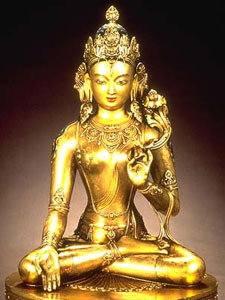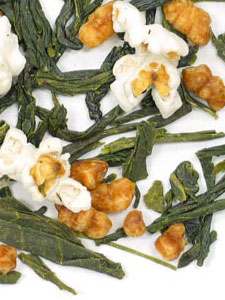Tea Stories


Legend has it that tea was discovered roughly 5,000 years ago by Chinese Emperor Shen Nung when a single leaf blew into the emperor's pot of boiling water. He found that not only did the leaf improve the taste of the water, but it seemed to have a stimulative effect on the body. The rest, as they say, is the history of the world's favorite beverage.
The second tea story comes as the Indian answer to the Ancient Chinese legend of Shen Nung's discovery of tea. According to this Indian tale, tea was a divine creation of the Buddha himself. During a pilgrimage to China, the Buddha was said to have taken a vow to meditate without rest for nine years. But, after some time, he dozed off. Upon awakening, he was said to have torn off his eyelids and thrown them to the ground out of frustration. Supposedly, the eyelids took root and germinated into plants that sprouted leaves with an eyelid shape. He then chewed the leaves of this plant, and his fatigue vanished. The plant, of course, was said to be the first tea plant, which he carried with him to China. However, it is important to note that there is no evidence that the Buddha ever went to China, not to mention that fact that he'd have bigger problems to worry about (besides staying awake) if he didn't have eyelids.
Another story recounts the origin of a popular tea in China, Ti Kuan Yin. According to the legend, Kuan Yin, the Goddess of Mercy, presented tea as a gift to a devout farmer who diligently maintained her old, dilapidated temple. Inside the temple was Kuan Yin's elegant iron statue to whom followers prayed for enlightenment. One day, however, the iron statue appeared to come alive. Shocked, the farmer fell to his knees and the goddess whispered,"The key for your future is just outside this temple. Nourish it with tenderness; it will support you and yours for generations to come." Unable to contain his curiosity, he went outside and found a withered, straggly bush.
After much care, the bush grew rich and full, with thick green leaves. Experimenting, the farmer dried the leaves in a stone wok. They soon turned a smooth charcoal black, just like the statue of Kuan Yin. The nectar produced from leaves fired in this way was ambrosial and fragrant, like the finest blossoms. It was more delicious than any other drink that ever touched his lips. Thus, the magical Ti Kuan Yin - "the tea of Kuan Yin" - came into being.
The next story describes yet another tea's origin. Unlike the other stories, this one lies not in the magic of legends, but in the practicality of economics. Also unlike the most of the tea stories mentioned, the origin of Genmai Cha is historically accurate. Contrary to the affordable luxury it has become today, tea used to be an extremely pricey commodity. The Japanese peasants found it difficult to afford larger quantities of tea, and would mix it with roasted rice, an abundant (and cheap!) product. Thus, they were able to squeeze more cups from the same amount of leaves. However, this tea has outgrown its humble origins to become a favorite of many urban dwellers in both Japan and the West, and is considered one of the more interesting variations on tea.
Tea's discovery by the West gave birth to the world's largest and most powerful monopoly. The power of the British East India Company, nicknamed "the John Company," was derived from the West's unquenchable thirst for tea and the unconscionable lengths the company would go to fulfill this demand. While consumers in the West desired tea, they were unable to find anything China wanted to trade for it - until they discovered opium. The British East India Company grew this harmful, inexpensive crop in neighboring India and traded it for Chinese tea. Because of its addictive nature, the demand for the drug spread rapidly. The British Tea Company's exploitative method of doing business resulted in lifetimes of addiction and ensured a practically endless supply of tea.
The final story deals not with the origin of a certain tea, but rather with the word "tea" itself. In China, tea is most commonly known as "cha". The reason we call it by another name reflects an interesting mix of history and geography. When tea first reached European markets in the late 16th and early 17th centuries, it came from the trading port of Amoy (present day Xiamen) in Fujian province of China. In the local Fukienese dialect tea is called "tey" rather than the more common "cha", so in Western Europe, and later the United States, it was the word "tea" that stuck, while other countries, such as India, Russia, and Turkey, were introduced to tea as "cha" by traders traveling over-land along the Silk Road.
As this lesson closes, more interesting and relevant tea stories keep coming to mind. It is no wonder that there are so many wonderful and intriguing legends associated with tea, considering the Muse which unites them.
 teaclass
teaclass
